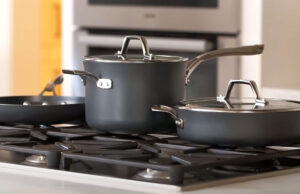As an Amazon Associate, I earn from qualifying purchases at no extra cost to you.
How to Install Dishwasher in Existing Cabinet Without Hassle
You open your kitchen cabinet and suddenly think, “This space could finally host that shiny new dishwasher!” But where do you even start? Don’t worry, I’ve been there—fitting appliances can feel like a puzzle sometimes. In this article, we’ll tackle installing a dishwasher in an existing cabinet in a simple way.
First, measure carefully to make sure the dishwasher fits. Turn off water and electricity to stay safe. Remove cabinet panels or shelves as needed, and prep the space. Connect the water supply, drain hose, and electrical wires correctly. Slide the dishwasher in, leveling it to prevent leaks. Secure it with screws, check for stability, and test a short cycle.
Measure and Prepare Your Cabinet Space
Start by clearing everything from the cabinet and surrounding area. Take a tape measure and note the width, height, and depth of your cabinet. Don’t just guess—dishwashers need at least an inch of extra space for hoses and air circulation. If your cabinet has a baseboard, consider removing it or adjusting the dishwasher’s legs so it slides in easily.
Next, check that the cabinet floor is level and strong. Any unevenness may cause the dishwasher to tilt or vibrate loudly. If you notice uneven spots, use shims to stabilize the base. Make sure there is easy access to the water supply line, drain pipe, and electrical outlet. This step prevents frustration later when connecting hoses and wires.
Remove shelves or drawers inside the cabinet that could block installation. Also, clear out anything around the plumbing or electrical connections. Sometimes cabinets have panels or kickplates that need temporary removal. Keep screws and small parts in a container so you don’t lose anything.
Finally, take a look at the dishwasher manual. Check the minimum required space and installation instructions. This helps avoid mistakes and ensures a perfect fit. Measuring and prepping properly saves time, money, and stress in the long run.
- Clear cabinet space completely
- Measure width, height, and depth accurately
- Remove shelves or panels as needed
- Check level and strength of the cabinet base
- Ensure easy access to plumbing and electrical
Turn Off Water and Electrical Supply
Safety comes first. Locate the water shut-off valve under the sink or near the dishwasher’s connection point. Turn it off fully and open a faucet to release remaining pressure in the pipes. This prevents water spraying everywhere when you disconnect old hoses. It may feel like overkill, but trust me—it’s worth it.
Next, switch off the circuit breaker controlling the kitchen outlet. Even if you’re confident, an accidental shock can ruin your day. Use a voltage tester if available to make sure no current is running to the wires. It’s better to take a few extra minutes than to deal with a painful mistake.
Remove any existing appliances carefully. For old dishwashers, disconnect the water supply, drain hose, and power cable. Keep towels or a small bucket handy for leftover water. Once the space is empty, double-check that water and power are off.
Finally, organize all your tools close by so you won’t have to run around. Have wrenches, screwdrivers, pliers, and hose clamps ready. A smooth setup makes installation much less stressful.
- Shut off water at the valve
- Release water pressure by opening a faucet
- Turn off the circuit breaker
- Disconnect old appliance carefully
- Keep tools nearby for easy access
Connect Water Supply and Drain
First, attach the water supply line to the dishwasher’s inlet valve. Use a flexible braided hose if needed. Hand-tighten initially, then secure with a wrench—don’t over-tighten to avoid damage. Apply plumber’s tape on threads for a secure, leak-free connection.
Next, handle the drain hose. Usually, it connects to a garbage disposal or sink drain. Make sure the hose loops up above the connection point to prevent backflow. Secure it tightly with clamps. Check for kinks or bends, which could block water flow.
If your kitchen didn’t have a previous dishwasher, you might need a T-connector for the water line or a standpipe for drainage. Take time to double-check measurements and alignment. Improper connections often cause leaks or poor drainage.
Test connections gently before pushing the dishwasher fully in. Turn water on slowly and watch for drips. If everything is dry and secure, you’re ready to move to the next stage.
- Attach water supply with tape and wrench
- Connect drain hose correctly with clamps
- Loop drain hose to prevent backflow
- Check for kinks or obstructions
- Test for leaks before final installation
Electrical Hookup and Safety Checks
Locate the dishwasher’s electrical junction box. Most use 120V outlets or direct wiring. If it’s a plug-in model, ensure the outlet is grounded and within reach. For hardwired units, connect the wires according to the manufacturer’s instructions. Match colors: black to black, white to white, green or bare to ground.
Secure wires inside the junction box with a cover. Double-check that nothing is pinched or exposed. Loose wires can cause shorts or fire hazards. Use wire nuts and electrical tape for added safety. Make sure the breaker is still off during this process.
After connecting power, gently push the dishwasher close to the cabinet space without fully seating it. Recheck all plumbing connections while it’s slightly out. Sometimes hoses shift or twist when moving the appliance, so a second check prevents leaks.
Turn on the power and run a short cycle once everything is in place. Watch for unusual sounds, leaks, or error lights. Fix any minor issues immediately before using it regularly.
- Match wires by color and secure with wire nuts
- Ensure ground connection is proper
- Cover junction box safely
- Check hoses before final seating
- Test with a short cycle
Slide Dishwasher Into Place and Level
Carefully slide the dishwasher into the cabinet space. Avoid dragging it on the floor to prevent scratches. Keep an eye on hoses and wires so they don’t get pinched or twisted. Pause if you feel resistance, adjust, then continue.
Next, level the dishwasher using adjustable legs. Use a spirit level to check front-to-back and side-to-side alignment. Proper leveling is essential to avoid leaks and ensure smooth door operation. Shims can help if the floor isn’t even.
Once level, secure the dishwasher to the countertop or cabinet frame with screws provided. Make sure it is snug but not overtightened to avoid cracking the countertop. Double-check that the door opens and closes smoothly.
Finally, inspect all connections one last time. Wipe any spilled water, run a test cycle, and listen for vibrations. If everything is stable and quiet, your installation is complete.
- Slide carefully avoiding pinched hoses
- Adjust legs and check level
- Secure with screws
- Test door movement
- Inspect and run a test cycle
Test and Troubleshoot
Before celebrating, run a complete cycle without dishes. Watch for leaks around water connections and drain hose. Listen for unusual sounds like grinding or rattling, which could indicate misalignment. Take notes of any issues to fix immediately.
Check the dishwasher’s spray arms and filters. Sometimes small packaging materials or screws from installation remain inside. Clean these out to avoid clogs. Ensure detergent dispensers open and close properly.
Observe the first few loads carefully. Small leaks or vibrations often appear during early use. Tighten any loose connections or adjust the level if needed. Troubleshooting early prevents damage to cabinets or floors.
Keep a small maintenance kit handy, including wrenches, tape, and spare hoses. Being prepared makes it easier to address minor issues quickly. After a week of smooth operation, you can feel confident your dishwasher is perfectly installed.
- Run an empty test cycle
- Listen for strange sounds
- Check spray arms and filters
- Observe early usage for leaks
- Keep tools ready for minor adjustments
Final Thoughts
Installing a dishwasher in an existing cabinet may seem tricky, but careful preparation makes it simple. Measure, connect, level, and test each part with patience. Safety comes first—water off, power off. Once done, the reward is a fully functional dishwasher without hiring a pro. With these tips, you’ll feel proud and confident in your DIY skills. Enjoy sparkling dishes and a happy kitchen!
| Task | Tools/Materials Needed | Tips | Common Mistakes to Avoid |
|---|---|---|---|
| Measure Cabinet | Tape measure, pencil | Measure 3 times | Forget extra space for hoses |
| Turn Off Utilities | Wrench, voltage tester | Double-check water/electric | Skip testing for leaks |
| Connect Water | Braided hose, plumber’s tape | Hand-tighten then wrench | Over-tightening |
| Connect Drain | Hose clamps | Loop hose for backflow | Kinks or bends |
| Electrical Hookup | Wire nuts, screwdriver | Match colors carefully | Loose connections |
| Slide & Level | Spirit level, shims | Adjust legs precisely | Door won’t close smoothly |
| Test | Towels, bucket | Run empty cycle | Ignore small leaks |
Frequently Asked Questions (FAQs)
Is it hard to install a dishwasher in an existing cabinet?
It can seem intimidating at first, but with careful planning, it’s very doable. Measuring accurately, turning off utilities, and following installation instructions are key. Beginners can manage if they take their time. Having basic tools like a wrench, screwdriver, and tape helps. Watching tutorial videos or checking manuals before starting also makes the process much smoother. A well-prepared approach reduces mistakes and stress.
Can I install a dishwasher without professional help?
Yes, most dishwashers are designed for DIY installation. If you follow safety steps—like turning off water and electricity—you can complete it yourself. The main tasks include plumbing, electrical hookup, leveling, and securing. Some kitchens may require minor modifications, but with patience, anyone can do it. Keep a manual handy and take each task slowly. If you feel unsure at any point, a quick consultation with a professional can clarify steps.
Do I need special tools for installation?
You don’t need anything exotic. A tape measure, adjustable wrench, screwdriver, spirit level, pliers, and plumber’s tape cover most needs. A voltage tester is helpful for safety. Some installations may require shims or clamps, but these are easy to get. Using the correct tools ensures a secure, leak-free installation. Avoid improvising with the wrong tools, as it can damage connections or the appliance itself.
Is it necessary to remove cabinet panels?
Often, yes. Removing shelves, panels, or kickplates helps the dishwasher slide in easily and gives access to plumbing and electrical connections. It also ensures accurate leveling and proper hose alignment. Keep screws organized so reassembly is easy. Skipping this step can make installation awkward or cause damage to the cabinet.
Can I install a dishwasher on my own if the floor is uneven?
Yes, but you need shims or adjustable legs to level it. An uneven floor can cause vibrations, leaks, or door problems. Carefully measure and adjust each leg until the dishwasher sits perfectly level. Using a spirit level ensures water drains correctly. Double-check after sliding it fully in place to confirm stability.
Do I have to run a test cycle immediately?
Absolutely. Running a short, empty cycle lets you check for leaks, misaligned hoses, or electrical issues. It also ensures spray arms move freely and the detergent dispenser works. Catching problems early prevents damage to your cabinet or floor. This step is quick but critical for a safe and smooth setup.
Is it safe to connect the dishwasher myself?
Yes, if you follow safety rules. Turn off water and power first. Match electrical wires correctly and secure connections. Use plumber’s tape for water connections and clamps for hoses. Avoid rushing, and double-check every connection. Being cautious prevents leaks, shorts, or accidents, making the installation completely safe for beginners and pros alike.
Can I move the dishwasher after installation?
You can, but carefully. Turn off water and electricity first, disconnect hoses, and avoid dragging it across the floor. Keep wires and hoses safe from pinching. When repositioning, check for level again before reconnecting. Moving without precautions can damage the appliance or connections. Always handle with care to protect your investment.




